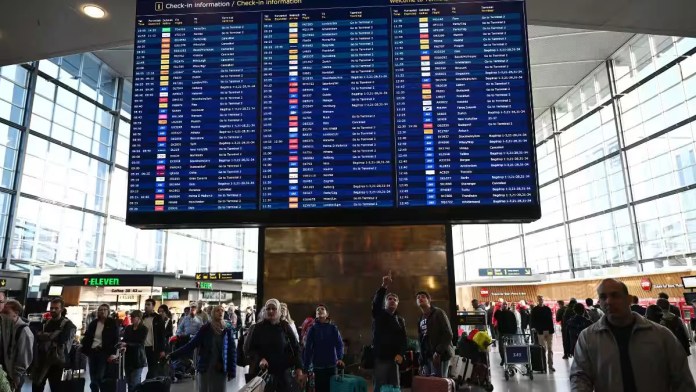GAZA CITY — In the dead of night on day 666 of the Israel Palestine Conflict, Israeli naval commandos boarded a civilian armada headed toward Gaza, seizing multiple vessels and detaining hundreds of passengers as the enclave reported a fresh surge in casualties from bombardments. The operation ignited a new round of diplomatic protests and moved the fight over law, relief, and blockade from court filings and press rooms onto the moonlit surface of the Mediterranean.
Organizers billed the expedition as the “Global Sumud Flotilla,” a civilian effort to spotlight Gaza’s dwindling fuel, oxygen, and medical supplies while testing the boundaries of a maritime cordon that has, in their view, become a wall. Israel, saying the blockade is lawful and necessary to prevent arms smuggling by militant groups, answered with swift interdictions typical of its long-honed interdiction playbook at sea. The result: a highly visible showdown that forced governments from Europe to Latin America to explain their positions yet again.
The confrontation did not materialize out of nowhere. In the weeks before the seizure, activists had meticulously staged a departure from Barcelona, framing the sea as both route and argument, a place where enforcement meets ethics, and where a blockade is either a security tool or a humanitarian choke point. For readers tracking the build-up, our earlier on-the-water explainer of the convoy’s risks outlined the political calculus behind sending dozens of nationalities into a zone that Israel defines as an active theater.
Even critics of the flotilla conceded that a handful of hulls cannot satisfy the enclave’s needs. But participants argued that spectacle can shift policy, that a line of small boats might bend a larger machinery toward relief corridors that are inspected, predictable, and genuinely open. Israeli officials countered that such voyages are theater that endangers sailors, drags navies into unnecessary confrontations, and risks laundering matériel to armed factions under a humanitarian sheen.
What happened on the water
As the cluster of boats neared the restricted zone off Gaza’s coast, night-vision boarding teams moved with practiced precision. Passengers in life vests pressed together on deck; crew members were ordered to idle engines and submit to search. Footage circulating within hours showed helmets, harnesses, and green-tinged images of commands shouted over the hiss of waves, live feeds from the decks verified by Reuters traced the choreography from approach to tow-away.

One boat reportedly broke briefly from the convoy’s formation before being redirected; most were escorted toward Israeli ports for processing. Consular officials sought access to nationals plucked from the flotilla, and lawyers began filing motions that mirrored a familiar script from past maritime showdowns. Much of this was prefigured when the convoy left Spain, as detailed in our report on the Barcelona departure after weather delays, which anticipated the legal and logistical bottlenecks that now define the aftermath.
Wire services had flagged the interdictions late Wednesday local time, with early dispatches noting the locations of initial boardings and the number of hulls peeled from the main line. Those first flashes, late-Wednesday intercept alerts from wire desks, soon gave way to more granular coverage: who was aboard, which governments were involved, and how the processing flow would unfold once the vessels reached port.
Inside Gaza: oxygen tanks, diesel, and the math of survival
While cameras tracked the drama offshore, Gaza’s hospitals and shelters endured another brutal cycle. Local health officials counted dozens of new fatalities through the night. ICU teams rationed oxygen and postponed non-urgent procedures; pediatric wards juggled power cuts with emergency intubations. The UN’s field updates summarized the daily grind of shortages, strikes, and displacement in a stark ledger, see the UN’s Gaza snapshot for Oct. 1 for the latest operational picture.

Doctors describe a balance sheet that never quite balances: diesel pooled in hospital courtyards for generators; blood banks running low by midweek; surgeons grabbing an hour of sleep on benches between mass-casualty intakes. Families sheltering in school compounds trade rumors of the flotilla between air-raid jolts, measuring hope against the reality that sea-borne sacks rarely make it to clinics by sunrise. For a deeper view of that system pressure, revisit our coverage of oxygen rationing inside overstretched wards, which mapped how generator downtime cascades into avoidable deaths.
The law of the waterline
Behind every boarding party sits a library of law. The San Remo Manual, a restatement of rules governing armed conflict at sea — is often cited to justify blockade declarations and enforcement, including interdictions in international waters when linked closely to a theater of hostilities. But even permissive readings of that text require attention to humanitarian obligations and proportionality. For primary-source context, see the San Remo Manual on Armed Conflicts at Sea, which has become the baseline citation in these arguments.
Israel’s case is straightforward: the blockade is publicly declared, operationally effective, and aimed at preventing arms smuggling; relief should move through inspected, authorized corridors, not through protest convoys that invite escalation. Legal critics counter that after nearly two years of warfare, the cumulative civilian toll renders the enforcement regime punitive in effect, if not in intent. A recent legal explainer on high-seas interdiction noted how distance from shore, civilian status, and the nature of cargo complicate bright-line claims of lawfulness — a debate unlikely to end with this convoy.
Beyond theory, the mechanics of checking hulls and cargo at sea remain a practical chokepoint. Our earlier coverage of the inspection regime at sea checkpoints traced why inspection lanes touted on paper often collapse under security alerts and shifting rules of engagement. The longer those breakdowns persist, the more pressure builds for parallel arrangements, the very pressure that fuels civilian flotillas built for visibility rather than volume.
Processing, deportations, and the politics of aftermath
What happens to detained passengers after a high-profile boarding? In past incidents, many were processed in Israeli ports and deported swiftly, while a subset faced prolonged questioning or legal proceedings. The same outline appears to be taking shape now, with consular officers seeking access and rights groups monitoring conditions. For an overview of the mechanics, see Reuters’ breakdown of Ashdod processing and deportation procedures.
The passenger list, a mosaic of medics, lawmakers, and veteran activists, guarantees that the story won’t stay contained to the port gates. Prominent names ensure parliamentary questions, committee hearings, and a rolling media cycle. The Washington Post compiled a roster of prominent detainees, a reminder that in modern conflicts, performer and audience share the same stage and often the same livestream.
In Europe, unions amplified the episode with calls for stoppages and rallies; in the Global South, capitals framed the boarding as a test of international court orders and humanitarian norms. For a comparative sweep, see Reuters’ digest of a sweep of reactions across capitals, and for street-level perspectives, Al Jazeera’s take on protests and union calls.
Politics ashore: parliaments, protests, and a moving target
Domestic politics shape every statement about the sea. In Italy, unions’ response to maritime seizures intersects with long-running debates over policing, migration, and the power of organized labor; in South Africa, solidarity with Palestinians carries the weight of anti-apartheid memory. Elsewhere, governments balance a familiar formula, Israel’s right to security plus humanitarian obligations, against the reality that images of commandos boarding civilian decks unsettle voters. And risk is not theoretical: our previous reporting on an earlier drone-scare around a flotilla vessel underscored how quickly maritime activism can blur into kinetic incident.
At the multilateral level, the argument loops back to recognition politics and corridor design. After a spate of recognitions and diplomatic shifts at the UN this year, some delegations see the flotilla confrontation as a symptom of larger paralysis. That’s why negotiations over monitored unloading points and verified delivery tracks have become the diplomatic obsession of the moment. For background on how those votes reframed the debate, revisit our analysis of the recognition wave that reshaped the UN corridor talk.
What civilian convoys can and cannot do
Civilian armadas aren’t supply chains; they’re statements. They cannot rebuild a grid, refit an ICU, or stabilize a drug schedule across hundreds of clinics. They can redirect attention, summon coalitions, and force procedural scrutiny in places accustomed to rubber-stamp approvals. Their scale, lines of small boats stitched together by satellite links, is what makes them both vulnerable and visible. That visibility has consequences, especially in a war where attention is a currency.
Israel bets that steady interdictions, minimal force at sea, and rapid deportations will blunt the flotilla’s impact while avoiding the lethal escalations that marked prior decades. Activists wager that repetition is strength: if one convoy is seized, launch another; if ports close, find new marinas; if cameras are jammed, stream from body-mounted rigs. Between those strategies sits a corridor that has eluded every summit communiqué: inspected pallets that travel on a timetable everyone honors.
Numbers behind the headlines
Each day adds fresh statistics, sorties flown, trucks inspected, patients ventilated, and removes something softer from the ledger: energy, patience, the stamina to parse another clip of boats bobbing under floodlights. Humanitarian dashboards track needs with admirable discipline, but families measure the war in something closer to breath: the hiss of oxygen in a neonatal ward, the rumble of a generator that stutters and dies, the hour a mother spends hunting for clean water. That’s why paragraphs about blockades and manuals feel so abstract in Gaza’s corridors. Still, as long as sea law shapes what gets through, the footnotes matter.
Looking ahead
Access and due process: Watch how quickly consular teams can see detainees, whether lawyers report interference, and whether any cases deviate from the usual deportation track.
Hospital lifelines: Track oxygen availability, generator fuel, and surgical backlogs. The best daily readouts are the UN updates and verified hospital reports bundled into operational snapshots.
Rules and realities: Expect a continuing duel of citations, from San Remo provisions to case-law analogies — and steady coverage unpacking whether the latest interdictions unfolded in international waters and under what authority. For context, AP’s legal explainer on high-seas interdiction lays out the questions likely to dominate the next briefing.
Public pressure: If unions escalate strikes and lawmakers lean into hearings, expect corridor negotiations to accelerate, not necessarily to delivery, but to new language about inspection protocols that either tightens the cordon or finally makes it porous.
Why it matters
For two years, residents of Gaza have been living through a daily emergency in which the difference between life and death is often measured in diesel and distance: the fuel that keeps oxygen plants running; the kilometers a truck travels before a checkpoint closes. The flotilla’s seizure changes none of that by itself. But the uproar it caused may add incremental pressure to a system that only moves under duress. In prolonged wars, progress rarely travels in straight lines. Sometimes it advances in the wake of a small boat.






























